(完整版)语义学理解
- 格式:doc
- 大小:93.16 KB
- 文档页数:12

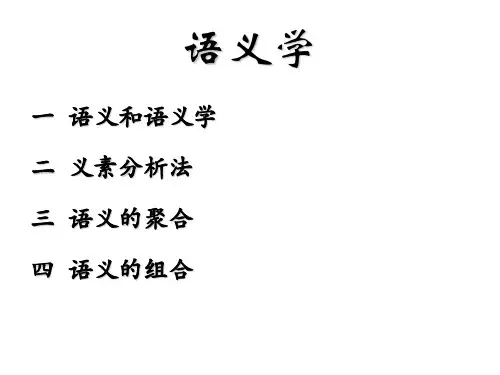
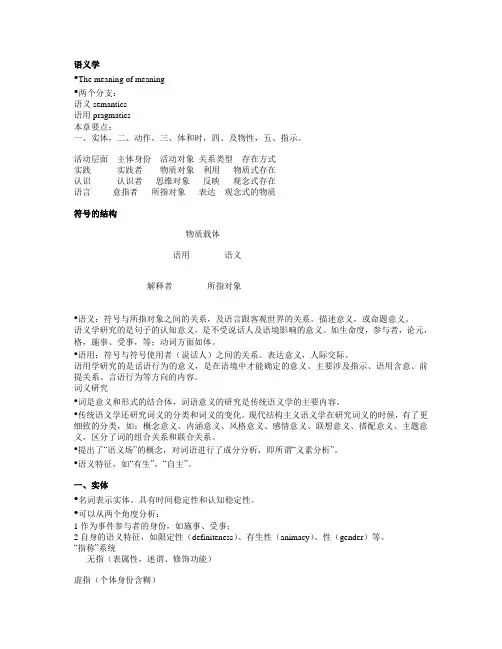
语义学•The meaning of meaning•两个分支:语义semantics语用pragmatics本章要点:一、实体,二、动作,三、体和时,四、及物性,五、指示。
活动层面主体身份活动对象关系类型存在方式实践实践者物质对象利用物质式存在认识认识者思维对象反映观念式存在语言意指者所指对象表达观念式的物质符号的结构物质载体语用语义解释者所指对象•语义:符号与所指对象之间的关系,及语言跟客观世界的关系。
描述意义,或命题意义。
语义学研究的是句子的认知意义,是不受说话人及语境影响的意义。
如生命度,参与者,论元,格,施事、受事,等;动词方面如体。
•语用:符号与符号使用者(说话人)之间的关系。
表达意义,人际交际。
语用学研究的是话语行为的意义,是在语境中才能确定的意义。
主要涉及指示、语用含意、前提关系、言语行为等方向的内容。
词义研究•词是意义和形式的结合体,词语意义的研究是传统语义学的主要内容。
•传统语义学还研究词义的分类和词义的变化。
现代结构主义语义学在研究词义的时候,有了更细致的分类,如:概念意义、内涵意义、风格意义、感情意义、联想意义、搭配意义、主题意义,区分了词的组合关系和联合关系。
•提出了“语义场”的概念,对词语进行了成分分析,即所谓“义素分析”。
•语义特征,如“有生”,“自主”。
一、实体•名词表示实体。
具有时间稳定性和认知稳定性。
•可以从两个角度分析:1作为事件参与者的身份,如施事、受事;2自身的语义特征,如限定性(definiteness)、有生性(animacy)、性(gender)等。
“指称”系统无指(表属性,述谓、修饰功能)虚指(个体身份含糊)无定(未识别的个体)实指(个体身份明确)有指(表个体)限定(已识别的个体)•无指:他是老师,木头房子•虚指:来客人了,请给孩子让座。
•实指:一只青蛙跳进池塘。
进来两个陌生人。
•限定:方枪枪也抬起头,只见自家那幢四层红砖楼赫然矗立在一枪射程内,顶层一间阳台上有一大一小两个人在凭栏远眺。


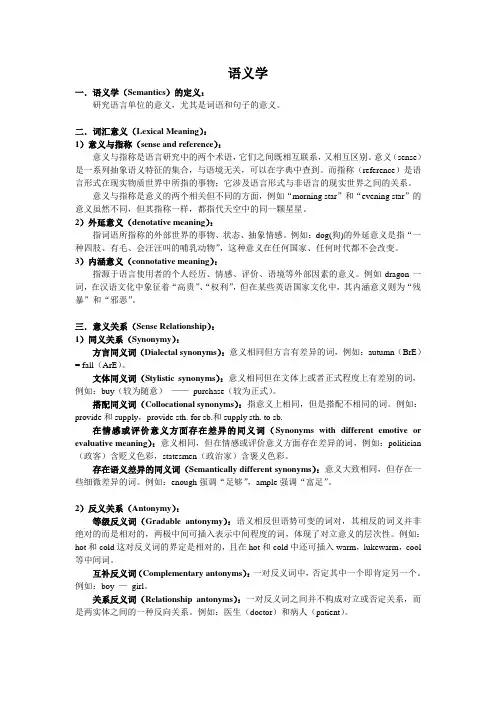
语义学一.语义学(Semantics)的定义:研究语言单位的意义,尤其是词语和句子的意义。
二.词汇意义(Lexical Meaning):1)意义与指称(sense and reference):意义与指称是语言研究中的两个术语,它们之间既相互联系,又相互区别。
意义(sense)是一系列抽象语义特征的集合,与语境无关,可以在字典中查到。
而指称(reference)是语言形式在现实物质世界中所指的事物;它涉及语言形式与非语言的现实世界之间的关系。
意义与指称是意义的两个相关但不同的方面,例如“morning star”和“evening star”的意义虽然不同,但其指称一样,都指代天空中的同一颗星星。
2)外延意义(denotative meaning):指词语所指称的外部世界的事物、状态、抽象情感。
例如:dog(狗)的外延意义是指“一种四肢、有毛、会汪汪叫的哺乳动物”,这种意义在任何国家、任何时代都不会改变。
3)内涵意义(connotative meaning):指源于语言使用者的个人经历、情感、评价、语境等外部因素的意义。
例如dragon一词,在汉语文化中象征着“高贵”、“权利”,但在某些英语国家文化中,其内涵意义则为“残暴”和“邪恶”。
三.意义关系(Sense Relationship):1)同义关系(Synonymy):方言同义词(Dialectal synonyms):意义相同但方言有差异的词,例如:autumn(BrE)= fall(ArE)。
文体同义词(Stylistic synonyms):意义相同但在文体上或者正式程度上有差别的词,例如:buy(较为随意)——purchase(较为正式)。
搭配同义词(Collocational synonyms):指意义上相同,但是搭配不相同的词。
例如:provide和supply,provide sth. for sb.和supply sth. to sb.在情感或评价意义方面存在差异的同义词(Synonyms with different emotive or evaluative meaning):意义相同,但在情感或评价意义方面存在差异的词,例如:politician (政客)含贬义色彩,statesmen(政治家)含褒义色彩。
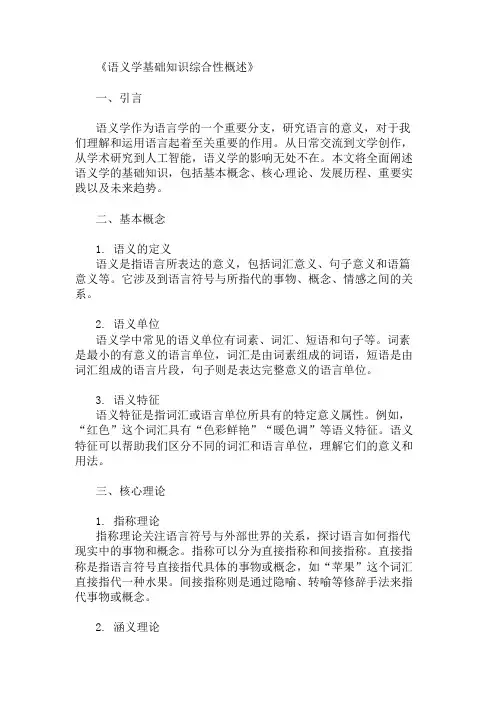
《语义学基础知识综合性概述》一、引言语义学作为语言学的一个重要分支,研究语言的意义,对于我们理解和运用语言起着至关重要的作用。
从日常交流到文学创作,从学术研究到人工智能,语义学的影响无处不在。
本文将全面阐述语义学的基础知识,包括基本概念、核心理论、发展历程、重要实践以及未来趋势。
二、基本概念1. 语义的定义语义是指语言所表达的意义,包括词汇意义、句子意义和语篇意义等。
它涉及到语言符号与所指代的事物、概念、情感之间的关系。
2. 语义单位语义学中常见的语义单位有词素、词汇、短语和句子等。
词素是最小的有意义的语言单位,词汇是由词素组成的词语,短语是由词汇组成的语言片段,句子则是表达完整意义的语言单位。
3. 语义特征语义特征是指词汇或语言单位所具有的特定意义属性。
例如,“红色”这个词汇具有“色彩鲜艳”“暖色调”等语义特征。
语义特征可以帮助我们区分不同的词汇和语言单位,理解它们的意义和用法。
三、核心理论1. 指称理论指称理论关注语言符号与外部世界的关系,探讨语言如何指代现实中的事物和概念。
指称可以分为直接指称和间接指称。
直接指称是指语言符号直接指代具体的事物或概念,如“苹果”这个词汇直接指代一种水果。
间接指称则是通过隐喻、转喻等修辞手法来指代事物或概念。
2. 涵义理论涵义理论研究语言符号所蕴含的意义和情感。
涵义可以分为概念涵义和情感涵义。
概念涵义是指词汇或语言单位所表达的客观概念,如“汽车”这个词汇的概念涵义是一种交通工具。
情感涵义则是指词汇或语言单位所表达的主观情感和态度,如“美丽”这个词汇的情感涵义是积极的、赞赏的。
3. 语义场理论语义场理论认为词汇不是孤立存在的,而是处于相互关联的语义网络中。
同一语义场中的词汇具有相似的意义和用法,它们之间的关系可以是同义关系、反义关系、上下义关系等。
例如,“红色”“蓝色”“绿色”等词汇属于颜色语义场,它们之间是并列关系。
4. 语用学与语义学的关系语用学研究语言在实际使用中的意义和效果,与语义学密切相关。
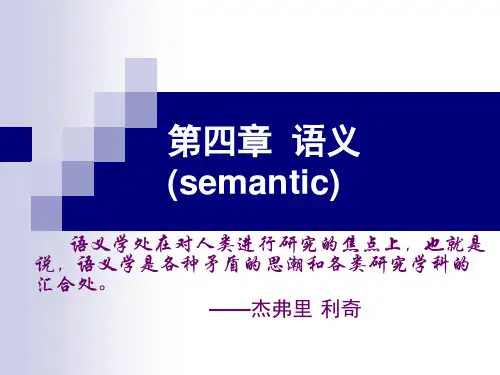

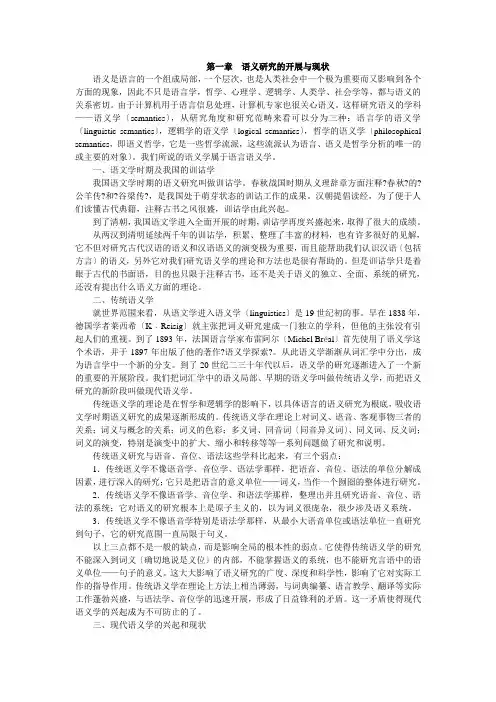
第一章语义研究的开展与现状语义是语言的一个组成局部,一个层次,也是人类社会中一个极为重要而又影响到各个方面的现象,因此不只是语言学,哲学、心理学、逻辑学、人类学、社会学等,都与语义的关系密切。
由于计算机用于语言信息处理,计算机专家也很关心语义。
这样研究语义的学科——语义学〔semantics〕,从研究角度和研究范畴来看可以分为三种:语言学的语义学〔linguistic semantics〕,逻辑学的语义学〔logical semantics〕,哲学的语义学〔philosophical semantics,即语义哲学,它是一些哲学流派,这些流派认为语言、语义是哲学分析的唯一的或主要的对象〕。
我们所说的语义学属于语言语义学。
一、语文学时期及我国的训诂学我国语文学时期的语义研究叫做训诂学。
春秋战国时期从义理辞章方面注释?春秋?的?公羊传?和?谷梁传?,是我国处于萌芽状态的训诂工作的成果。
汉朝提倡读经,为了便于人们读懂古代典籍,注释古书之风很盛,训诂学由此兴起。
到了清朝,我国语文学进入全面开展的时期,训诂学再度兴盛起来,取得了很大的成绩。
从两汉到清明延续两千年的训诂学,积累、整理了丰富的材料,也有许多很好的见解,它不但对研究古代汉语的语义和汉语语义的演变极为重要,而且能帮助我们认识汉语〔包括方言〕的语义,另外它对我们研究语义学的理论和方法也是很有帮助的。
但是训诂学只是着眼于古代的书面语,目的也只限于注释古书,还不是关于语义的独立、全面、系统的研究,还没有提出什么语义方面的理论。
二、传统语义学就世界范围来看,从语文学进入语义学〔linguistics〕是19世纪初的事。
早在1838年,德国学者莱西希〔K﹒Reisig〕就主张把词义研究建成一门独立的学科,但他的主张没有引起人们的重视。
到了1893年,法国语言学家布雷阿尔〔Michel Bréal〕首先使用了语义学这个术语,并于1897年出版了他的著作?语义学探索?。
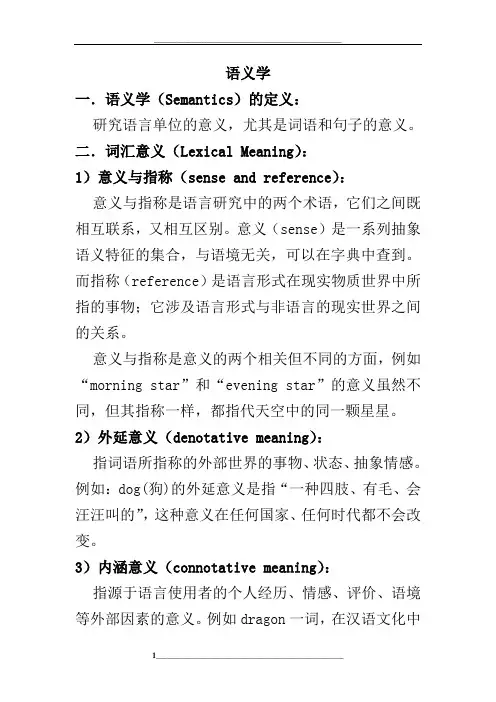
语义学一.语义学(Semantics)的定义:研究语言单位的意义,尤其是词语和句子的意义。
二.词汇意义(Lexical Meaning):1)意义与指称(sense and reference):意义与指称是语言研究中的两个术语,它们之间既相互联系,又相互区别。
意义(sense)是一系列抽象语义特征的集合,与语境无关,可以在字典中查到。
而指称(reference)是语言形式在现实物质世界中所指的事物;它涉及语言形式与非语言的现实世界之间的关系。
意义与指称是意义的两个相关但不同的方面,例如“morning star”和“evening star”的意义虽然不同,但其指称一样,都指代天空中的同一颗星星。
2)外延意义(denotative meaning):指词语所指称的外部世界的事物、状态、抽象情感。
例如:dog(狗)的外延意义是指“一种四肢、有毛、会汪汪叫的”,这种意义在任何国家、任何时代都不会改变。
3)内涵意义(connotative meaning):指源于语言使用者的个人经历、情感、评价、语境等外部因素的意义。
例如dragon一词,在汉语文化中象征着“高贵”、“权利”,但在某些英语国家文化中,其内涵意义则为“残暴”和“邪恶”。
三.意义关系(Sense Relationship):1)同义关系(Synonymy):方言同义词(Dialectal synonyms):意义相同但方言有差异的词,例如:autumn(BrE)= fall(ArE)。
文体同义词(Stylistic synonyms):意义相同但在文体上或者正式程度上有差别的词,例如:buy(较为随意)—— purchase(较为正式)。
搭配同义词(Collocational synonyms):指意义上相同,但是搭配不相同的词。
例如:provide和supply,provide sth. for sb.和supply sth. to sb.在情感或评价意义方面存在差异的同义词(Synonyms with different emotive or evaluative meaning):意义相同,但在情感或评价意义方面存在差异的词,例如:politician(政客)含贬义色彩,statesmen(政治家)含褒义色彩。
(完整版)语义学理解语义学各个领域对语义学的看法语义学(Semantics),也作“语意学”,是一个涉及到语言学、逻辑学、计算机科学、自然语言处理、认知科学、心理学等诸多领域的一个术语。
虽然各个学科之间对语义学的研究有一定的共同性,但是具体的研究方法和内容大相径庭。
一、语言学的语义学研究目的在于找出语义表达的规律性、内在解释、不同语言在语义表达方面的个性以及共性;其主要有三个分支:1结构主义语义学:从20世纪美国结构主义语言学发展而来,研究内容是词汇的意义和结构,如义素分析、语义场等,也可称为词汇语义学,词和词之间的各种关系是词汇语义学研究的一个方面,例如同义词、反义词,同音词等,找出词语之间的细微差别。
2生成语义学:20世纪六七十年代流行于生成语言学内部的一个语义学分支, 借鉴了结构语义学对义素的分析方法,比照生成音系学的音位区别特征理论,主张语言的最深层的结构是义素,通过句法变化和词汇化的各种手段而得到表层的句子形式。
3形式语义学:最初的研究开始于蒙太古以数理逻辑方法对英语的研究,后来经过语言学家和哲学家的共同努力,发展成为一个独立的学科,并且摒弃了蒙太古对生成语言学的句法学的忽视,强调语义解释和句法结构的统一,从而最终成为生成语言学的语义学分支。
二、逻辑学的语义学是对一个逻辑系统的解释,着眼点在于真值条件,不直接涉及自然语言;现代的逻辑学,或者说形式逻辑、数理逻辑等,其目的是设计出来一套形式语言系统,并对其作出语义解释。
这样的形式语言系统是一个个抽象的封闭体系.一个逻辑系统通常由三个部分组成,即词汇部分、句法部分和基于模型论的语义部分。
所谓的词汇部分就是列举出一个形式系统所使用的所有符号,句法部分是这些符号的组合规则,规定什么样的符号序列可以是这个系统的句子,语义部分是对合格句子的解释,这样的解释通常是:在一个模型中进行的对真值条件推导。
逻辑学的语义学着眼点在于逻辑系统的语义解释,是一个理想化的模型系统,不直接涉及自然语言。
语义学名词解释(20分左右)语义学名词解释(20分左右)1、系统意义和外指意义:①意义等于系统意义和外指意义之和,以语境为中心,按照语言内和语言外为标准,可将意义分为系统意义和外指意义。
不少学者认为这是语义学研究的最重要原则之一,也是区分语义学和语用学的分水岭。
②系统意义与语境无关,仅仅涉及语言成分内部之间关系的意义,它是意义的中心,系统意义包括系统意义关系和系统意义特征。
③外指意义表明词语跟语言外部世界关系的意义。
2、命题义:命题义相当于描述义或概念义,是句义的中心所在,它是对客观事物的一种概括性描述。
3、句义:句义指一个合成表达式的意义,是其组成部分的意义函数。
一般来说,句义是词汇意义和句法意义的结合。
4、话语义:话语义指某个句子在特定情景中所具有的意义。
5、语义特征分析法:语法学所说的某一小类实词的语义特征是指该小类实词所特有的,能对它所在的句法格式起制约作用的,并足以区分其他小类实词的语义内涵和语义要素。
6、衔接的基本概念:衔接是句法或语义层面上的一种连接。
在功能语言学中,指前后对照的一些代词、副词、冠词等成分,连接起句子中的不同部分或语篇中的各个部分。
7、连贯的基本概念:连贯是语篇组织的主要原则之一,涉及对语言使用者的背景知识、做出的判断以及持有的假设等内容的研究,特别是如何通过使用语言行为实现连贯的交流。
8、情态:情态是一个语义范畴的概念,表达说话人对所说话内容的态度,也可以说是肯定或相信的态度。
9、蕴涵的基本概念:蕴涵是指两个命题之间存在的如下关系:一个为真时,另一个随之必为真,反之不然。
词汇和句法结构均可以造成蕴涵。
10、实质蕴涵:①真命题可以被任何命题所蕴涵②假命题可以蕴涵任何命题11、严格蕴涵:前件和后件有必要性,要求前件和后件有必然性,希望能保证|从某一个命题出发能必然的推出一个真命题。
12、相关蕴涵:希望能保证|在前提和结论之间具有某种|共同内容或意义关联。
13、衍推:语句P衍推语句q,当且仅当若P为真,可以由P内在的推导出q为真,记作P=>q14、衍推序列:①具有衍推关系的语句形式|有序集,我们把这个有序集叫做衍推序列。
1. Semantics:is a word derived from Greek stem “seme” which meant sign, first coined by semantique M.Breal in 1893. And it was first cited by British scholar in an English report entitled “ Reflected Meaning : a point in semantics”.2. There is no definite answer to the question “what’s the meaning of meaning”. In order to get the meaning of word, we should depend on the concrete contexts we refer to.Eg: I meant to come early. (intentional meaning)The real flag means danger. (conventional meaning)The dark cloud means rains.( natural meaning)Calligraphy means beautiful writing. ( linguistic meaning)Study linguistic phenomena within the language system, not outside.Ogden and Richard “ the meaning of meaning” in 1923, listed at list 16 different understandings of meanings.Although different scholars hold different attitudes towards what’s the meaning of meaning, they do share something in common, that is , to explicate linguistic phenomena, the knowledge that language use must have in order to make certain judgment concerning meaning of words and sentences of their language.3. judgment made by language uses(1) ambiguityPolysemous words in the sentenceEg: she cannot bear children ( put up with)Certain structures: adj + n in possessive case + NAdj + a series of nounsMore/most + adj +nV-ing + nounResulting from elliptical structureEg; serve meat when thoroughly stewed.Homonymous wordsEg: when does the baker follow his trade?Whenever he needs( kneads) the doughLiaisonEg: a train deara trained deera trained earit rained here,.(2) anomalyAnomaly refers to a phenomenon that various words in certain combination are anomalous. This means the combination violate semantic rules, though in agreement with grammatical or syntactical rules.Eg: grean idears sleep furiously-violated semantic rules, unaccepatable combinatione.g. I ate three phonemes for brbeakfast(3) ContradictionContradiction refers to a certain combination that is contradictory.Eg: 你以为咱家有金山银山啊My brother is the only childColourless green ideas sleep furiously(4) RedundancyRedundancy is very common in language, it is one of the features of language.Eg: I went yerterday你用脑袋好好想一想用鼻子闻一下毫无根据的诽谤(5)equivalenceEquivalence means that the propositions contains in sentences are equivalent, not sentences themselves--- it also used in logic, referring to certain sentences are equivalent in truth value.Eg: The textbook is on the top of the desk.(6) EntailmentSome sentences or propositions logically entail other sentences or propositions.Eg: A: Mary killed spy.B: The spy died.Proposition: a statement is a proposition if it can be judged either T or F. ( one sentence may contain different propositions) ( different referents express different propositions)Eg: I an a teacher.A: He almost manage to win the electionB: He didn’t win the electionA entails BA: Now he had a passport again. Bill will be able to leave the countryB: Bill left the country.A: John is a bachelor.B: John is unmarried.Some patternsPersuade sb to do sthPersuade sb thatEg: A: I persuade John to give the first three lecturesB: John gave the first three lectures( not entail)A: I persuade John that he was wrong.B:John accepted that he was wrong.( entail )A: If you don't come before 5 o’clock. You don’t find him at home.B: You will find him if you come before 5 o’clock.In this case, A doesn’t entail B, because “not” in A functions not only a negative mark but also shows different meanings. A means that you nay or may not find him before 5 o’clock.4 Various theories of meaning4.1 referential theory of meaningRefrence:(指称关系)Refrent:(指称物)Referring expression: (指称表达式)---the relationship between language and worldAccording to this theory, linguistic expression is what it refers to or stands for. (It is modest, because it has its own significance in the study of meaning, emphasizing relatedness of language to the world. It is too extreme, reducing language to its reference. It is the first theory to explore relation between language and world.)Why is it too extreme?It is not convincing: for example, one-one relationGeorge Bush (linguistic expression): a real person; the president of U.S.( referents)One linguistic expression has more than one referent.Problems:1. Meanings can not be equivalent with reference.e.g. Venus(金星)/启明星/长庚星Different expressions may refers to the same thing( one referent), but mean quite differently, even when meaning and referent are identical in the following sentence containing “I”.I attend the meeting Friday. One-a lot of (relation)2. This theory proves to be invalid, incapable of explaining expressions which do not have referent but intuitively speaking, they are meaningful.e.g. Marilyn Monroe spends a very wonderful life.Your apple is very sweet.The above sentences have no referent at all.This meaning is invalidated in the theory of meaning.4.2 The ideational theory of meaningAccording to this theory, the meaning of expression is the idea or the concept associated with it in the mind of anyone who knows the expression. (Changeable, flexible, different people may form different pictures when exposed to the object.)The idea or images called concepts are fleeting (changing), and then ideas are changing.4.3 Behaviorist theory of meaningAccording to this theory, the meaning of expression is either the stimulus that evokes or the response that it evokes or a combination of both in particular occasions of an utteranceThe relation between language and stimulus is not one to one, but quite complicated, perhaps one to many.e.g. One girl sees apples on the table and she want an apple. She may express this intention in different ways.a. Look at those apples. I am hungry. Would you please fetch one for me?b. You know I love apples.c. I beg you cannot get that apple with a wooden leg.- These responses are quite different in meaning, not valid to explain meaning.- Each theory has its own contribution to a certain degree in the study of meaning.4.4 The meaning-in-use theoryAccording to this theory, the meaning of expression is determined by if not in identical ways its use in the language. The language use cannot be separated from contexts, so the use meaning is also contextualism.Problems:a.Meaning shouldn’t be taken as use. Meaning is logically prior to use. The use theory is questioned.b. This theory is too over generalized and doesn’t have much actual value, because context itself is not enough for analyzing meaning.c. To equate meaning with context, we can only account for simple instance of language use.d. Context is related with objective world, and knowledge about word is so much limited, we cannot totally rely on this knowledge to analyze meaning, nor can we extend the scope of semantic study to the study of the world.4.5 The verification theory of meaning--Falsifiability--Truth value theory, truth- conditional theoryLeech’s classification of meaning--This theory is advocated by Vienna Circle ( a group of people in pursuit of empiricism) and Schick is the authority one.-- According this theory, the meaning of an expression, if it has one, is determined by verifiability of the sentences or propositions containing the expression.--This theory just provides a criterion of judging whether a proposition is meaningful or not instead of what is meaning.-- Schick said that stating the meaning of sentence amounts to stating the rules according to which the sentence is to be used.This is the same as stating the way in which it can be verified or falsified.Problems:1. It is hard to determine how many observations or statements will be enough to verify a proposition. ( infinite in number )e.g. My brother is bald.For time being, whether or not I have a brother.For time being, whether or not my brother is bald.The meaning of the above sentence is determined by a set of observations/ statements and statements are observational statements.They provide the mean for observationally verifying whether the speaker has a brother and for time being whether he is bald. If this statement is verified, the proposition is true or it is false.2. Secondly, only deals with the meaning of declarative sentence which make statements.4.6 The true-conditional theory of meaning (logic semantics)-- According to this theory, the meaning of expression is contribution to the truth conditions of sentences containing the expression.-- Truth conditions are conditions under which propositions prove to be true or false.Chapter 3. Types of MeaningThere is intrinsic connection between meaning and communication in semantics. (Intentional transmission of meaning)In semantics, intentional transmission of communication by means of some established signal system. (Language)3.1 classifications of signals1. verbalGrammatical linguistic and lexical linguistic2. non-verbal(1) Linguistic (vocal; intonation; stress)(2) ParalinguisticVocal (loudness, tone of voice, tempo)Non-vocal (eye movement; facial expression, gesture)(3) non-linguisticVocal: individual voice3 qualityNon-vocal: blush3.2 classification of meaning3.2.1 Propositional meaning/conceptual/referential/denotative/According to Herford O Hensley, propositions are things that are true or false. A proposition is that of meaning of the utterance of declarative sentence which describes some states of affairs. The difference between sentence and proposition:a. Proposition is not the same as a sentence. The same sentence can express different propositions by means of the reference, because a speaker indicates which things or persons in this world are talked about.e.g. here, there, nowb. Because of ambiguityThe same sentence may express different propositions.e.g. Vagueness----referent---- not clear ( feature of language )Possessive case:This is Jean’s picture.The picture taken by Jean.The picture belongs to Jean.The picture of Jean.3.2.2. Social meaning: language is social phenomenon(1) Illocutionary meaning(2) Speaker/ addressee(3) Stylistic / register(1) Illocutionary meaning---when we utter a sentence, we are performing a certain speech act from the perspective of semantics. It expresses a kind of logical meaning.e.g. It’s a nice day!I state it a nice day! ----- perform a sentence---illocutionary force.Propositional meaning vs. illocutionary meaningSometimes we can have illocutionary meaning without propositional meaning to perform speech act expresses illocutionary forcee.g. Good morning can’t be judged true or false.In uttering sentences, we perform speech act under felicity condition.e.g. In the evening, people are going to go asleep, it is not proper to say have a nice day.(2)Speaker/addressee relationshipPower vs. solidarityThe speaker may have the power over the addressee, vice versa.e.g. In Chinese, we have 你and 您, in French we have tu and vous, but in English we don’t have this kind of phenomena.Different pronouns indicate different relationship between speaker and addressee.Solidarity shows the equal relationship between the speaker and hearer.T/V: tu/vous formTReciprocal vs. non-reciprocalTerms of addressingWhen addressing somebody, you can use different terms. Different choices of terms in a way may reflect a speaker and addressee relationship.Terms of addressing: the point is under the topic of “power and solidarity”. This point is related to social meaning which we can study in a diachronic way.e.g.①We often call some colleagues teacher Wang or teacher Li, which shows that the speaker and the addressee is equal in status. And sometimes we call some of our colleagues XiaoLi or XiaoWang, which shows that the speaker is older than the addressee. In terms of age, the speaker has the power over the addressee.②The addressing term may change with the time. We often use “同志” in Chinese, but in English the correspondent word “comrade” has another meaning (gay or homosexual). So English people don’t use this word so often. From the 1950s to present, the meaning of “comrade” has been extended and it has derogatory meaning, thus people don’t have positive association of the word meaning.③In the 1970s or 1980s, we have the addressing terms of “师傅” and “徒弟” in the factory. At present, we call the taxi driver “师傅” instead of “comrade” or “driver”, though we don’t have the “徒弟” relationship.师傅:master, master worker徒弟:apprentice, follower, discipleThe addressing terms change with the time, which shows the changing and development of society have influence on language. The changing of addressing terms reflects the emotional meaning. Two points concerning social meaning in terms of speaker/addressee relationshipT/T form is more common than the T/V form. T/V form is more often used in grammatical system, while in English there is no such kind of grammatical terms to show solidarity and power of speaker and addressee relationship. But we can use titles, such as Mr., Miss, Mrs.e.g. when we say “This is Mr. Smith” which is very formal. We can say “This is Tom” to show the intimate relationship. If we are good friends, we use a given name only, a shortened family name, or even the nickname. Such as Charles, Charli or Chuck.(3) Stylistic/register meaning.These two are related, but not the same, both of them can be defined as the variety of language depending on the use rather than the user.User: dialectsStyle: is defined as situationally distinctive use of a variety of language.(e.g. oral form & written form; formal form & informal form, literary form, colloquial form, technical form)Register:is closely used in linguistics and sociolinguistics. It is a variety of language defined according to its use in social situation.Their conceptual/propositional meanings are the same, but register/ stylistic meanings are not.e.g.分analyze the problem (chemist)析dissect the subject (medical)问expounded the problem (missionary)题explain/ make it clear (colloquial form by common people)Three points concerning stylistic/ register meaning①formality vs. informalityWhen we talked about register, we talk about formality and informality.e.g. 流汗:informal: sweat, formal: perspireIn different context, we use different words.②provinceIt is referred to the professional or academic fields.e.g. program: computer program 计算机程序,TV program 电视节目③modeWhen we talk about mode, we talk about writing and speech. Writing is more formal than speech, but not always.Phrasal verbs are less formal than single verbse.g. 提出(理论):propose, put forward, set forth, come up with, advance, initiate, advocate, etc. The point is proposed by Leech: synonyms are used in different contexts, but the conceptual meanings are the same.e.g. Home: formal: domicile/ residence, in poetry: abodee.g. Small: little, tiny, wee(Scottish dialect), diminutive (formal)3.2.3 Emotive/ indexical meaningIt concerns the use of certain expression through which we can find speaker’s identity or status. It is not conveyed by linguistic components, but by non-linguistic components, such as voice quality (passive voice or active voice)①emotional/ emotive meaning expresses speakers or writers attitude of emotional involvement, it focus on speaker and writer. Sometimes emotional meaning overlaid on propositional meaning. e.g. when the black people were transported to America as slaves, their master often called them “nigger”, later on, they called them “negro” to show their low social status contrary to their master. In the 1960s, they were called “black people” instead of “negro” contrary to the white. Later on, they called them “Afro-American”. Form this we can see the addressing terms change with time, the emotional involvement involved in these terms change with the time.②emotional meaning is expressed without propositional meaning through tone of voice, intonation or intonation pattern. This kind of meaning can be judged as true or false as it expresses certain state of affairs.e.g. the baby which/ who you saw this morning.“Which” is acceptable according to grammatical rule. When we use “which”, it means we treat baby/ the man as something instead of a person, “which” shows the speaker is more separate/ distant from the things involved. “Who” shows more personal feeling with the person or man.3.2.4 Thematic meaningBy thematic meaning, in different sources, the terms are similar. But different scholars may use different terms: theme vs. rheme; topic vs. comment; given information vs. new information; background vs. focus. All these terms are used to show thematic meaning.Definition given by Leech: thematic meaning derives from theme. It is communicated by the way in which a speaker or writer organized the message in terms of ordering, focus or emphasis. Thematic meaning may be different according to what the speaker wants to emphasize or highlight. Under this one, we have three points:①normally, the propositional meaning must be the same. In this case, we can compare thematic meaning. This kind of meaning can be expressed by either verbal or non-verbal component. Verbal componen t means the arrangement of words.Non-verbal component means intonation, stress and etc, which are used to accompany verbal signals.②Thematic meaning is expressed by voiceNormally, active or passive voice counterparts express the same propositional meaning, but different lies in the thematic meaning.e.g. i. Marry donated the first prize. (The first prize is new information.)ii. The first prize was donated by Marry. (Mary is new information.)For the first sentence, the author wants to highlight “what is donated.” For the second sentence, the author wants to emphasize “who donated the first prize.”e.g. i. Everyone in this class speaks two languages.ii. Two languages are spoken by everyone in this class.For the first sentence, the people in the class can speak two languages, but the languages are not fixed. For the second sentence, the people in this class speak two fixed languages, such as English and French, or English and Germany. The propositional meaning maybe change when the thematic meaning changes.If the voice transfers, the propositional meanings are different. Quantifier and negation transfer will cause the change of propositional meanings.③ Thematic meaning is expressed through other grammatical constructions.e.g. i. A student is waiting ouside.(waiting outside is new information.)ii. There is a student waiting outside.(a student waiting outside is new information.)The proposition meaning is the same, but thematic meaning is changed. First part, “there be” is old information.Change order:e.g. i. They stopped at the end of corridor.(at the end of corridor is new information.)ii. At the end of corridor, they stopped.(they stopped is new information.)④ Thematic meaning is expressed through intonation, stress to highlight one part of sentence.e.g. i. ‘John kept the watch. (it is John, not somebody else who kept the watch.)ii. John ‘kept the watch. (it is kept, not buy or else)iii. John kept the ‘watch. (it is watch, not something else that John kept.)Connotative meaning is proposed by Leech. Connotative meaning is the communicative value, an expression has by means of what it refers to over and above its purely conceptual content.e.g. woman [+human, +adult, -male] Psychological meaning and physical characteristics, not social. Male is unmarked.Woman’s associate meaning: patient, irrational, wear skirt, gentle, kind, prone to tears, good at cooking, capable of speech, expression, sentimental.Connotative meaning is not what is included in language system. People should draw a distinction between speaker’s attitudes and what is encoded in the language system.Further discussion on proposition meaning:(1) Different between valid and invalid inferencesPremise i:Premise ii:Conclusion:e.g. premise i: All men are mortal. (T)premise ii: John is a man. (T)conclusion: John is mortal. (T) valid inferencee.g. premise i: All men are mortal. (T)premise ii: Fido is not a man. (T)conclusion: Fido is not mortal.(F) invalid inferenceIf “not” appears in premise, the conclusion is difficult to get.(2) Different between valid and truth conclusione.g. premise i: All men are mortal.(T)premise ii: God is not a man. (T)conclusion: God is not mortal.(T) conclusion is true, but it is invalid inference. Since without premise i and ii, the conclusion is still right. According to common sense, the conclusion “God is not mortal” is unrelated to premise i and ii.(3) Difference between deductive and inductiveDeductive inference: the truth of the premise guarantees the truth of conclusion. It is from general truth to particular facts.Inductive inference: the method of reasoning from particular facts to general truth.e.g. premise i: Professor Smith had 200 students in his class at beginning of the semester.Premise ii: Three weeks later, he had only 10 students in his class.Conclusion: Professor Smith course is unpopular.This adopts the deductive method, but the conclusion is invalid.There are two conditions:①The number of the students in the Mr. Smith’s class is not the convincing evidence to prove whether Mr. Smith’s class is popular or not.②Maybe, at first the students thought the course provided by Mr. Smith is interesting at the first sight, but when they attended the class for themselves, they finally find that it is very hard for them to follow the teacher; therefore they were absent form the teacher’s class.(4) Analytic proposition and synthetic propositionNormally, analytic proposition is one whose truth is independent of the way the world we live in happens to be. The truth of this kind of proposition is true in all possible words.In contrast, synthetic proposition is one whose truth is dependent on the way the world we live in happens to be.(Analytic:措辞为真,保证命题为真,synthetic:需用事态来衡量)e.g. All spinsters are unmarried.This is analysis proposition, since its truth is independent of the world we live in.e.g. My brother is a bachelor.This is synthetic proposition, since its truth is dependent on the verification of whether the speaker has a brother or not and whether or not for the time being her/ his brother is a bachelor.(5) the propositional calculusThe basic formation of proposition: simple proposition and complex proposition.Simple proposition is one that doesn’t contain any constituent propositions within it.Complex proposition is one that is formed from one or more constituent propositions by means of connective.“and”, “and then”, “or”, and “not” are logic connectives. They are also called operators.e.g. John did not buy a Ford.(it is a simple sentence, but a complex proposition with “not” in it.) e.g. they got married and they got a baby. (“and” shows the logic order. It is different from “and” in the sentence “Mary and I go to the cinema.”)(6) truth function connectiveA connective is said to be truth functional if and only if the truth value of the complex propositions formed by applying it to one or more constituent propositions. It is fully determined by the truth values of those component propositions.(如果构成复合命题的各自命题为真,则复合命题为真;如果构成复合命题的各子命题不能保证为真,则connective不具有真值涵项性)Truth Table①同真为真,一假为假p q p&qT T TF T FT F FF F F②一个为假,则为假if前件…then后件,p→qp q p qT T TT F FF T FF F Fp q p v (or)q T T TT F TF T TF F F p q p≡q p ) q T T TT F FF T FF F Te.g.: John went to Paris before Mary died1 2This is a complex proposition. Supposed that 1 and 2 are the facts, but the connective “before” is not truth functional, since we can not decide whether or not John went to Paris before or after.e.g.: The question is discussed in the aspects or syntactic structure.The connective “or” is truth functional“and” conjunction“v” “or” discojunction inclusive 讨论的是命题“)” if…then 蕴含关系implication“≡” equivalence“~” negation[8]. Formation of structure of simple proposition(1) Predicate 谓元vs argument 主元Structure of simple proposition is formed by combining predicate with one or more arguments. e.g.: Mary is tall.Argument predicateJohn loves Mary.Argument predicate argumentBy predicate, we mean a term which is used in combination with a name in order to give some information about individual that the name refers to. Usually verbs, adjectives and common names are used as predicates.Argument: According to John Lyons, something which is named or talked about usually proper names are used.e.g.: Brute is a mouseProper name common namesArgument predicateThe classification of predicate: one-place, two-place, three-placeAccording to the number of arguments, they are combined to form a simple proposition.e.g.: Mary is tall. ------------One-placeThis one is preferable to that one-------------two-placeHe gave me a rose----------three-placeI bought this clothe from Internet for 100RMByuan. -----------four-placeTraditionally, the classification of predicates is according to the number of objects.No-objects one-object two-objects4. structural semantics: sense relation4.1 Structural semantics states or analyzes the meaning of words in terms of their association with other words in the language system.Association is the key word. Words in the vocabulary form a kind of relation in the system. Semanticists focus their attention on what is called implicational lexical relations. The main concern is lexical meaning.4.2 Sense relation: refers to the relations of sense holding within sets of lexemes.“sense”, this term was used early in the last century, may at the end of the 19th century. A famous scholar Fregue drew a distinction between sense and reference. If we use the sense of a word, we mean its place in the system of relationships which it contrasts with other words in the vocabulary of certain language.Reference: studies the relation between language and the world.Sense: studies the relation within the language systemWhy people use “sense”, this term instead of “meaning”?since meaning is too general and vague, we need to be specific we use sense instead of meaning. 4.3 Six types of sense relation-----可以用蕴含公式表达Square not triangle incompatibleCat ←→ not dogEasy ←→ difficult → antonymWife ←→ husband → converseSingle ←→ married → complementary4.3.1 Hyponymy (superordinates, originally called inclusion by analogy.)Hyponym 共同下义词e.g.: He caught a sparrow.------ He caught a bird.(yes, entail)He didn’t catch a sparrow. ------ He didn’t catch a bird. (No)This is a rose. -------- This is a flower. (Yes)I hate roses. ----- I hate flowers. (No)n →谓语(蕴含关系)n →宾语(一般不是)----Hyponymy is a relative notion not absolute one, which means a certain lexemes or words maybe surperordinates in contrast with one set of words, but may also be hyponyms in contrast with other sets of words.----Vocabulary of natural language tends to have many gap related to what we are talking about. e.g.: lexical gap: (1) 阉割(2) no common superordinates for word colourcolour ←→ white shape → triangle, squareblack, yellow(The parts of speech of hyponymy must be the same)4.3.2 Synonymy----Synonyms can be categorized into 2 types:(1)Absolute synonyms: refers to the synonyms which are interchangeable in all contexts.e.g.: word-formation = word buildingNorth Korea → fatherland→ motherland→ homeland(2)Relative synonyms:refers to those synonyms with common basic meaning but slightlydifferent in terms of use or meaning. Such synonyms are abundant in any language.e.g.: beautiful---pretty---charming---attractiveempty---vacant---hollow-----In different contexts, we use different synonyms. Many synonyms may have different senses which are in contrast with different synonyms and antonyms. Different senses contrast with different linguistic item.e.g.: He is a bit high. = He is a bit drunkhigh。
语义学的专业名词解释汇总语义学是研究语言意义的学科。
它关注的是人类语言中词汇、短语、句子以及更大的语言单位的意义和语用。
语义学涉及了许多专业名词,下面将对其中几个重要的概念进行解释,以帮助读者更好地了解这门学科。
1. 语义语义是指词汇、短语、句子或更大的语言单位的意义。
语义学试图解释语言的意义如何构成,并分析语义如何在不同上下文中变化。
2. 语言符号语言符号是指语言中用来表示意义的各种单位。
这可以是个体音素、单词、短语、句子或更大的单位。
语言符号的选择和组合形成了语义。
3. 合成语义学合成语义学是语义学中的一个分支领域,它研究语义是如何通过词汇的合成来进行构建的。
合成语义学关注的是合成词、派生词和词根的意义如何相互作用来形成复杂的词汇意义。
4. 语义角色语义角色是指在一个句子中扮演特定语法功能的实体或概念。
比如,在句子"I ate an apple"中,"I"是执行动作的主体,"an apple"是被动作所影响的对象。
语义角色有助于理解句子的含义和结构。
5. 句法-语义界面句法-语义界面是语义学与句法学之间的接口领域。
它研究句法结构和语义结构之间的关系,以及如何根据句法结构来解释句子的意义。
6. 语用学语用学是语义学的一个重要分支,它关注语言如何在特定上下文中被使用和理解。
语用学研究与语言背后的目的和意图有关的因素,以及如何通过语言来达到特定的交际目标。
7. 词义消歧词义消歧是语义学中一个重要的问题,它指的是在不同的上下文中如何确定一个词的确切意义。
例如,词语 "bank" 可以指银行,也可以指河岸,根据上下文不同,需要确定其具体含义。
8. 语义演化语义演化研究语言意义如何随时间变化。
词语的意义在不同的历史时期和社会环境中可能发生变化。
通过研究语义演化,可以了解词汇的历史变迁以及人们对词汇意义的认知。
以上仅是语义学中一小部分重要的概念和名词的简要解释。
语义学各个领域对语义学的看法语义学(Semantics),也作“语意学”,是一个涉及到语言学、逻辑学、计算机科学、自然语言处理、认知科学、心理学等诸多领域的一个术语。
虽然各个学科之间对语义学的研究有一定的共同性,但是具体的研究方法和内容大相径庭。
一、语言学的语义学研究目的在于找出语义表达的规律性、内在解释、不同语言在语义表达方面的个性以及共性;其主要有三个分支:1结构主义语义学:从20世纪美国结构主义语言学发展而来,研究内容是词汇的意义和结构,如义素分析、语义场等,也可称为词汇语义学,词和词之间的各种关系是词汇语义学研究的一个方面,例如同义词、反义词,同音词等,找出词语之间的细微差别。
2生成语义学:20世纪六七十年代流行于生成语言学内部的一个语义学分支, 借鉴了结构语义学对义素的分析方法,比照生成音系学的音位区别特征理论,主张语言的最深层的结构是义素,通过句法变化和词汇化的各种手段而得到表层的句子形式。
3形式语义学:最初的研究开始于蒙太古以数理逻辑方法对英语的研究,后来经过语言学家和哲学家的共同努力,发展成为一个独立的学科,并且摒弃了蒙太古对生成语言学的句法学的忽视,强调语义解释和句法结构的统一,从而最终成为生成语言学的语义学分支。
二、逻辑学的语义学是对一个逻辑系统的解释,着眼点在于真值条件,不直接涉及自然语言;现代的逻辑学,或者说形式逻辑、数理逻辑等,其目的是设计出来一套形式语言系统,并对其作出语义解释。
这样的形式语言系统是一个个抽象的封闭体系.一个逻辑系统通常由三个部分组成,即词汇部分、句法部分和基于模型论的语义部分。
所谓的词汇部分就是列举出一个形式系统所使用的所有符号,句法部分是这些符号的组合规则,规定什么样的符号序列可以是这个系统的句子,语义部分是对合格句子的解释,这样的解释通常是:在一个模型中进行的对真值条件推导。
逻辑学的语义学着眼点在于逻辑系统的语义解释,是一个理想化的模型系统,不直接涉及自然语言。
但是在形式语义学中,很多的语义学概念是从逻辑学的语义学中引申来的。
三、计算机科学相关的语义学研究在于机器对自然语言的理解;逻辑编程语言Prolog。
四、认知科学对语义学的研究在于人脑对语言单位的意义的存储及理解的模式。
语义学分支1哲学语义学这是哲学家对自然语言的语义的研究,围绕着什么是意义这一难题展开。
古希腊时代柏拉图(约公元前428~前348)以为既然词语是用来指称事物,为它命名的,词语的意义就是其所指对象。
这种原始的观点称为指称论。
可是有些词语,例如“当今法国皇帝”,虽然有意义,却没有指称对象,因为当今法国没有皇帝。
于是有人退一步说:意义是词语在说话者和听话者头脑中产生的形象或者观念。
然而这个说法也有缺点。
说词语的意义是形象,太具体,因为同一个词可以唤起不同的形象;说词语的意义是观念,又太笼统,因为观念本身是未知数,靠观念来确定意义不过是用一个未知数代替另一个未知数。
由于观念论说明不了意义,有些哲学家如D.戴维森便试图另辟途径,确立词语与世界的联系。
他们提出, 语句的意义与命题的真假有关。
这种观点称为真值论。
在真值论基础上发展出真值条件语义学,可能世界语义学及各种模式 -理论语义学。
维特根斯坦(1889~1951)反对真值论,他认为词的意义是它在语言中的用法。
他的理论叫做用法论。
用法论不象真值论那么狭窄,因为许多语句没有所谓真值,如疑问句、祈使句都无所谓真假,但是任何词语必有一定的用法。
可是用法论也有缺陷,困为“用法”的概念不明确。
后期的语言游戏论,认为“语言游戏论=自然语言分析+心理行为分析”。
维特根斯坦后期的转变不仅是语言基础的转变———从理想语言转到自然语言,也是分析方法的转变———从单纯的语言分析转到语言分析与心理分析的结合。
英国哲学家J.L.奥斯汀 (1911~1960)也反对真值论,他从另一个角度来弥补真值论的不足,他认为说话不仅是“言”,而且是“行”,因而话语有双重作用,一是陈述命题,二是起命令、请求、许愿、警告之类的言外作用。
真值论研究前一种意义,言语行为论则研究后一种意义。
对什么是意义的争论,还在进行。
言语行为:二三五二:行为式和表述式三:语谓行为、语用行为、语效行为五:语用行为:判定式、执行式、承诺式、表态式、阐述式塞尔继承和发展了奥斯汀的理论。
语言哲学的意义第一,从方法论的角度看,20 世纪后半叶语言学和语言哲学的发展形成句法学、语义学和语用学的三分框架和三种基本的语言分析方法,这个意义很大。
凭借这种新工具、新方法,我们能够知道自己和他人的语言结构(即语言符号的空间排列规律)、语言意义(即语言符号的指称和涵义)、语言效用(即语言符号与使用者的关系,亦即语言符号用来“做事”的能力)。
人与其他动物的本质区别是什么?不过就是使用语言符号。
凭借这种语言符号,人能够正确思维和正确行事,人和人之间能够成功交际,最了不起的是,人还能凭借语言符号建构社会现实。
第二,从世界观的角度看,语言哲学的发展形成了“主体-语言-世界”的三元结构世界观。
第三,从科学发展的角度看,以上发展催生了认知科学。
首先从语言探索心智的是乔姆斯基。
外在语言(E- language)和内在语言(I- language)的区别。
“外在语言”是乔姆斯基用来表示语言的个体特征和语言多样性的一个术语。
外在语言是外部的,是与心-脑结构无关的。
外在语言的另一个特征是任何人都可以随心所欲地创造它。
因此,外在语言只是一种语言现象。
乔姆斯基使用“内在语言”这个术语有几重含义。
首先,它是一种心脑状态(mind- brain state),是儿童在学习语言的时候所获得的东西。
它是高度抽象的,远离日常的语言行为和结构。
内在语言不过就是心脑初始状态的一个范例。
其次,内在语言是人类实现语言能力的机体组织,是心脑组织的一个部分,它类似于视觉系统,但它是专供语言使用的。
其三,内在语言就是语法。
乔姆斯基认为,我们称为“语法”的东西,实际上是在理想的说话者-听话者模型中对知识的表达。
语言学家发展的语法理论并不是复制中心神经系统实际的编码过程,而是通过发展内在语言的理论,清晰地说明生成语言的过程和图像。
1968 年,乔姆斯基在《语言与心智》一书中阐述了过去、现在和将来语言学对心智研究的贡献,自然语言的形式和意义,语言的形式特征,语言和哲学,生物语言学和人类语言能力。
在乔姆斯基的语言理论中,两个假设和理论前提是唯理主义和心理主义,由此推出的最核心的概念是先天语言能力(Innate Language Faculty, ILF)和普遍语法(Universal Grammar, UG)1历史语义学语文学家早就关注语义问题,尤其是词义演变问题。
中国和西方学者都作过大量而细致的词源和训诂研究。
1893年,法国学者M.布雷阿尔第一次使用“语义学”这一名称,1897年出版了第1部专著《语义学探索》。
19世纪末到20世纪前半叶,欧美学者整理、归纳了词义演变的各种现象,分为词义扩展、词义紧缩、词义升值、词义贬值等类别。
英国S.乌尔曼在20世纪50~60年代出版几部著作,总结了这方面的研究成果。
2结构语义学在结构主义理论影响下,一些语义学者由历时性的研究转向共时性的研究,由研究一个词的语义变化转向研究词与词的语义关系。
20~30年代,德国和瑞士的一些语言学家创立了语义场的理论,代表人物是J.特里尔。
他们把一种语言中的全部词汇看成一个完整的系统,系统中各个词项按意义聚合成为若干语义场。
每个词的意义都取决于同一场内其他词的意义,例如要确切了解“红”的意义,必须了解“橙”的意义。
他们还有另一类颇为流行的方法,那是对词与词之间的同义、反义、多义、歧义、上义、下义等种种关系的研究。
但是结构语义学有个局限性,即只以词或语素为单位,既没有考虑如何对词义内部结构进一步分析,也没有考虑如何把词义组合成词组、句子的意义。
从40年代起,音系学家把音素分解为更基本的元素,美国人类学家也把各种语言中表示亲属关系的词如"父"、“母”、“弟”、“妹”、“夫”、“妻”等分解为男性、女性、成年、未成年、已婚、未婚等等成分。
在他们的影响下,人们也开始采用成分分析法来研究语义。
3生成语法学派语义学1963年J.卡茨和J.A.福多发表了论文“语义理论的结构”,标志着生成语法学家开始研究语义。
次年卡茨和P.波斯塔尔的专著《语言描写的统一理论》出版,将语义学和句法学、音系学并列为生成语法学的 3大分支。
a生成语法学的总目标是描写和解释人们的语法知识,其中语义学的目标则是描写和解释人们的语义知识。
每个说汉语的人都知道:"母亲"和“妈妈”语义相同;“男人”、“女人”、“老人”、“青年人”的语义不完全相同,但有共同之处,所讲的都是“人”;“人”的范围大,“男人”的范围小。
语义学家的任务,就是假设一套理论来说明这些词语的意义特点及其彼此之间的种种关系。
卡茨等以成分分析法为基础,设计出一套元语言来给自然语言的词语下定义。
例如“单身汉”一词含有人、成年、男性、从未结婚等意义,因而词义可以用下面这一组元素表示:“HUMAN”、“ADULT”、“MALE”、“ NEVER-MARRIED”。
“男人”的词义可以用“HUMAN”、“ADULT”、“MALE”表示,"人"的词义只须用“HUMAN"表示。
但是有的元素本身就是个复合体,例如“HUMAN”含有实体、物体、动物、理性等意义,可以进一步解析为:“OBJECT”、“PHYSICAL”、“ANIMAL"、"RATIONAL"。
如果两个词语所含的元素相同,就彼此同义。
如果两个词语有一个或几个共同元素,彼此之间就语义相似。
共同的元素越多,语义越接近。
假如甲词有3个元素,乙词除了这3个元素外还有第4个元素,则乙词的意义包含在甲词的意义范围之内。
b除描写词的意义外,语义学还必须描写一切词组和一切句子的意义。
在生成语法学派的句法学中,句法元素结合成有层次的树形结构,这叫做句法表达式。
卡茨假设,在语义学中,语义元素也结合成有层次的树形结构,这叫做语义表达式,如 HUMAN的语义表达式应该是:句法学用句法规则把单词组合成词组,把词组组合成句子,把若干简单句组合成复杂句,这样便能造出无穷无尽的句子。
语义学以句法表达式为基础,用语义规则把词的意义组合成词组的意义,把词组的意义组合成句子的意义,把简单句的意义组合成复杂句的意义,这样便能得出任何一个句子的语义。
在分析句法的时候循着句子、词组、单词的顺序分解;在分析语义的时候,也可以相应地把大单位分解为小单位。
这套语义理论,称为分解理论。
c如上所说,语义理论以句法为基础,先生成句法表达式,然后转变为语义表达式。